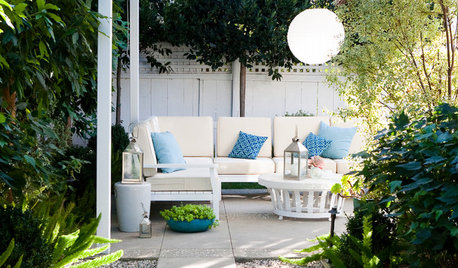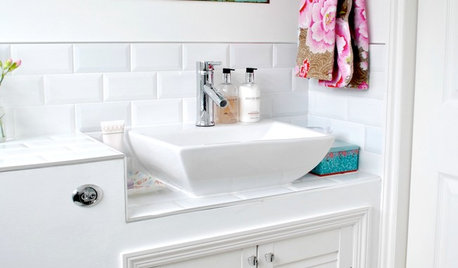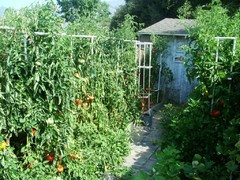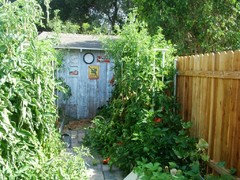Ready for the next 3 days of rain
Allie Szot
8 years ago
Featured Answer
Sort by:Oldest
Comments (38)
Seysonn_ 8a-NC/HZ-7
8 years agoncrealestateguy
8 years agoRelated Discussions
broccoli fine one day....3 flopped over the next
Comments (7)Cutworms are quite common in the garden and their damage is relatively easy to prevent. The most common tried and true method is to simply slide a thicker stick right along side the stem of the transplant. If the cutworm can't wrap around the stem with his body he can't damage it. Many folks use a big nail, a popsickle stick, a piece of a plastic drinking straw, a thick twig, etc. just use your imagination. Some also use collars made from all sorts of things - strips of aluminum foil, toilet paper rolls (though they get wet and cave in), strips of plastic, etc. They just need to fit up against the stem snugly but not tight enough to interfere with growth. And there is always corn meal but it has to be reapplied after rain. They eat it, swell up and die. Just Google 'cutworm control' for all sorts of tips and tricks. Dave...See MoreRE: Burrr.. Ready for next floating lettuce crop?
Comments (1)Hydrogenie, Where are the pics of your first setup..?...See MoreGetting ready to plant next weekend need advice.
Comments (24)Merry Heart, We got down to 34 degrees last night, and had frost forming right about 3 a.m. and I DIDN'T cover up my plants. I wanted to, but the wind gusted hard all day and there was no way I could have gotten those big sheets of plastic out and over the plants. The plastic would have blown away before I could use something to tie it down. When the skies started clearing late in the afternoon, I knew we were in trouble. And, when the wind stopped blowing after sunset, I knew we were in deep trouble. I went outside at 3:30 a.m. and turned on the sprinkler, hoping to give my plants a chance of surviving what was rapidly becoming a very hard frost. I moved the sprinkler once an hour. I just checked on my tomato plants, and they seem fine. I'm not so sure about the beans and corn. They don't seem as fine, but I'll wait a few hours longer to see if they either perk up....or look worse. And, if you don't find Espoma anywhere in Ardmore, let me know. My DH will be picking up some for me one day after work this week, probably on Fri. or Sat., and he could pick up some for you at the same time. Once it is here at my house, we will figure out how to get it from me to you. You can come here, or I can come to Ardmore, or whatever. I know Carla would pick up some and ship it, but you and I are within easy driving distance of each other, and there's no need for y'all to spend money on shipping. Ilene, I used Epsom salts for a couple of years. I really couldn't see much difference in my tomato plants, but it made a HUGE difference in my pepper plants. The plants were large and green and lush. I didn't get as many peppers as usual those 2 years, though, and I haven't tried it since. I'm not sure why it didn't seem as helpful to the tomato plants as to the peppers. And I don't know if the Epsom salts had anything to do with the decreased pepper production or if it was just a bad year for peppers. Ilene, I've posted a link to Reinhard Kraft's website. He has photos of over 800 heirloom tomatoes in his photo gallery. Many of the ones he grows are the same ones we grow here in the USA. He has been active in promoting heirlooms for a long time, and has sent seed to gardening friends in the USA for trial and vice versa. And, y'all, we have just too much wildlife around here. When I was out during the night putting the sprinkler on the garden, there were raccoons on the porch (nothing there for them to eat, but that didn't stop them from looking), rabbits in the semi-tall grass along the fence line between our place and the neighbor's place, and coyotes.....at least one on our place near the barn, and one on the neighbor's place between their house and ours. The coyotes were howling back and forth. I know coyotes seldom attack humans, but it made me a little bit nervous. Hoping to work in the garden this afternoon after it warms up! Dawn Here is a link that might be useful: Reinhard Krafts website and fotogalerie...See MoreDo I spray my peach tree again if it rains the next day or wait?
Comments (4)First what are the active ingredients in your Bonide fruit tree spray? I do not use that product but do use Imidan and Captan on my peaches. Normally I do not re-spray after getting rained out unless the rainfall was over an 1". If less than 1" rainfall then I wait until I need my next application. This would depend on how rainfast the ingredients are in your mix. Many insecticides/fungicides are totally washed off if rainfall is 1" or more. Unless they have systemic action. I presume the directions for no more than 3 applications a year are to help reduce the chance of resistance being developed. I also spray sweet cherries and Haralson apples with Ortho Fruit,Flower and Vegetable spray and it has a similar warning (active ingredient of acetamiprid). The only bad news about this is that if you need to spray more than 3 times a season then you have to use a different product the rest of the time that does not have the same active ingredients. I would think if you e-mail or call Bonide they will help you. I tried that with a product a few years ago and found the chemical manufacturer had a horticulturist on staff and they answered all my questions....See Morecentexan254 zone 8 Temple, Tx
8 years agolast modified: 8 years agorgreen48
8 years agogorbelly
8 years agolast modified: 8 years agoAllie Szot
8 years agogorbelly
8 years agolast modified: 8 years agoncrealestateguy
8 years agogorbelly
8 years agoSeysonn_ 8a-NC/HZ-7
8 years agolgteacher
8 years agoqaguy
8 years agoncrealestateguy
8 years agoAllie Szot
8 years agoAllie Szot
8 years agoncrealestateguy
8 years agoAllie Szot
8 years agoncrealestateguy
8 years agoAllie Szot
8 years agogorbelly
8 years agolast modified: 8 years agoHumsi
8 years agoAllie Szot
8 years agolast modified: 8 years agogorbelly
8 years agoAllie Szot
8 years agoAllie Szot
8 years agogorbelly
8 years agogorbelly
8 years agoSeysonn_ 8a-NC/HZ-7
8 years agoncrealestateguy
8 years agoHumsi
8 years agolast modified: 8 years agoqaguy
8 years agoncrealestateguy
8 years agodaniel_nyc
8 years agolast modified: 8 years agoSeysonn_ 8a-NC/HZ-7
8 years agoqaguy
8 years ago
Related Stories

HOMES AROUND THE WORLDMy Houzz: Montreal Update Ready Just in Time for a New Arrival
A remodeled bathroom, new lighting, better storage and a modern color palette refresh a 3-story home for this expecting couple
Full Story
OUTDOOR KITCHENSOutdoor Room of the Day: This Patio Cooks, Even in the Rain
Washington homeowners create their dream outdoor kitchen with a pizza oven, gas grill, fireplace and more
Full Story
GREEN BUILDINGOff the Grid: Ready to Pull the Plug on City Power?
What to consider if you want to stop relying on public utilities — or just have a more energy-efficient home
Full Story
GARDENING AND LANDSCAPING21 Patios Ready to Party
Mix up some margaritas and break out the barbecue sauce. Outdoor party season is upon us, and these patios show how to do it right
Full Story
LIFEReady Your Home for Fall to Savor the Season More
Settle into the pleasures of autumn with a home that's prepped, organized and full of seasonal delights
Full Story
ORGANIZINGGetting Ready for the Hurricane: What's on Your List?
Tell us what you do to prep for emergencies like a hurricane
Full Story
KITCHEN DESIGNAre You Ready for a Dark and Sophisticated Kitchen?
Black kitchen cabinets have a rich, timeless look. Get ideas for your next cabs — and how to paint the ones you have
Full Story
FEEL-GOOD HOME12 Fresh Updates to Get Ready for Spring
As spring approaches, embrace the brighter days with these uplifting changes and additions to your home
Full Story
HOLIDAYSHoliday Party Prep: Ready Your Supplies
Take stock of serveware, wash off the dust and clear out the pantry now for low-stress entertaining later
Full Story
MOST POPULARBudget Beach House: A Trailer Gets Ready for Summer Fun
Punchy prints and colors star in a creative approach to Jersey Shore living
Full Story








centexan254 zone 8 Temple, Tx